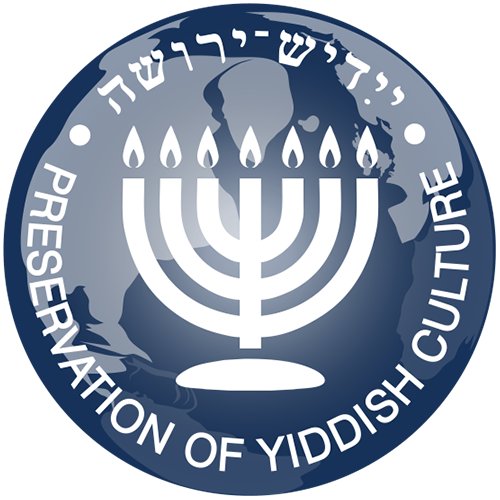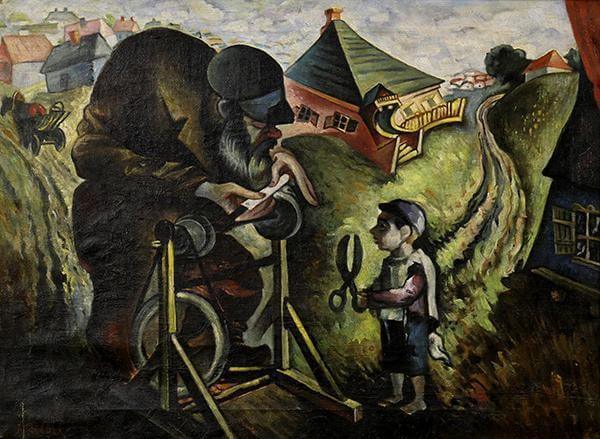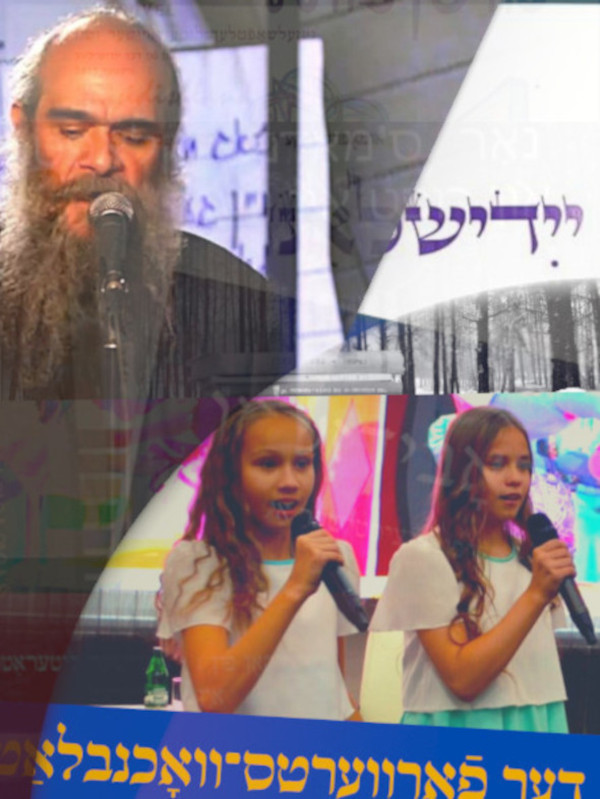Yiddish Culture
The Yiddish language is the very foundation of Ashkenazi Jewish culture. Although the vast majority of today’s Ashkenazi Jews don’t speak Yiddish any more, up until WWII this language had a tremendous influence on virtually all the aspects of their culture.
At first glance, Ashkenazi culture is a broader term than Yiddish culture, because it includes Yiddish as its linguistic component. However, we insist on the term Yiddish culture and its equivalents both in English and other languages. For example, while Anglophones are accustomed to speak of Yiddish culture in particular, in Russian “идиш-культура” may sound like an unnatural calque from English. The word “Yiddish” in Russian is always a noun; there is no corresponding adjective, because traditionally, especially in the Soviet era, the language would be simply called Jewish (“еврейский”) in accordance with the plain meaning of the language’s name. Nevertheless, we find appropriate to introduce this concept into Russian as well. In fact, we borrow it from Yiddish (yidish-kultur) rather than English. Unlike the expression yidishe kultur, which means “Jewish culture”, this compound noun in an exact and concise way designates everything related specifically to Yiddish, including various phenomena transcending the boundaries of Jewish or Ashkenazi identity. For example, Zalmen Zylbercweig (1894-1972), a renowned historian, occasionally uses this term in his monumental 6-volume Leksikon fun yidishn teater (Lexicon of Yiddish Theatre) to emphasize Yiddish as such, not necessarily as something belonging entirely to the Jews.
We must not forget that Ashkenazi Jews for at least three centuries had been the largest group of the Jewish people and played a leading role in the cultural, religious and political life of Jews in general.
Issachar Ber Ryback. The Sharpener. 1922
Those Ashkenazi Jews who consciously abandoned Yiddish in favor of modern Hebrew, which differs in its pronunciation and other features from the traditional Ashkenazi Hebrew, became the core of the new fledgling Hebrew-speaking Israeli-Jewish nation. Its culture, however, is for the most part foreign to what may be defined as Yiddish culture. The process of cultural consolidation of the Israeli-Jewish nation is not yet complete. There is a clearly distinct Ashkenazi subculture in Israel. However, its identity is mostly ancestral rather than linguistic. Therefore, to avoid confusion, we will use the term Yiddish culture – linked specifically to Yiddish – in both English and other languages.
Chronologically and conceptually, Yiddish culture may be divided into its early and new forms. The early Yiddish culture is reflected, most importantly, in folklore and works of various authors who often drew their inspiration from folkloric sources. Various poetic and prosaic Yiddish works from the 14th till the early 19th century represent a broad variety of genres ranging from epics and hagiography, to homilies and fairy tales.
The emergence of modern Yiddish literature is linked to the Enlightenment philosophy, which found its Jewish expression in the Haskalah movement, which sought to modernize and rationalize Jewish life. Paradoxically, the Maskilim, the adherents of Haskalah, usually viewed Yiddish in an extremely negative light, but still used Yiddish as the de facto language of the Jewish masses to promote their ideas and, most importantly, to introduce the then popular genres of European literature.
A rapid development of modern Yiddish culture began in the 1870s. The classics of modern Yiddish prose, who elevated it to the level of the best examples of European literature of that time, were Mendele Moykher-Sforim (whose real name was Sholom-Yakov Abramovich, 1836-1917), Yitskhok-Leybush Peretz (1852-1915) and Sholem Aleichem (whose real name was Sholom Rabinovich, 1859-1916). Another important figure was Shimon-Shmuel (Semyon) Frug (1860–1916) who, together with Peretz, laid the foundation of modern Yiddish poetry.
The playwright, poet and stage director Avrom Goldfaden (real name Goldenfoden, 1840–1908) is considered the father of professional Yiddish theater (and Jewish theater in general). Early Yiddish culture, with its Purimshpil (folk theater linked to the holiday of Purim) and badkhens (jesters who entertained Jews at weddings and other celebrations, often acting as toastmasters), had a great impact on the development of modern theatrical genres. The early musical tradition of klezmers, Jewish folk musicians, greatly influenced the development of modern and truly professional Jewish music, and theater as well.
At first, this new modern Yiddish culture was often poorly received by Jewish intellectual elites. In the traditional Jewish society, Hebrew was considered the sacred language revered with the greatest esteem, while the vernacular – Yiddish – was merely viewed as a mundane tool of daily communication. Even while themselves writing in Yiddish, the “enlightened” Maskilim treated it with disdain and considered it a “jargon”. However, this originally pejorative term had become quite popular among the Yiddish speakers themselves, up until the early 20th century, and was broadly used without any negative connotations.
In the 1880s this unfavorable situation began to change. The philosophy and ideology of Yiddishism, which emerged at the time, set the task of creating a modern national Jewish culture based on Yiddish, as the traditional language of the Ashkenazi Jews who, moreover, constituted the majority of the Jewish people as a whole. The ideas of Yiddishism were actively promoted by Yitskhok-Leybush Peretz. Two national Jewish historians and literary critics, Shimon (Semyon) Dubnov (1860–1941) and Yisroel (Sergey) Tsinberg (1873–1939), who wrote mainly in Russian, had emphasized the importance and need for the development of Yiddish literature. These historians provided convincing ideological and scientific grounds to assert their view.
Already at the very beginning of the 20th century, this attitude towards Yiddish as a “low” language began to change. Paradoxically, Chaim-Nachman Bialik (1873‒1934), who was by no means a supporter of Yiddishism, played a substantial role in this change. Although Bialik is considered a classic of modern Hebrew poetry, he left a relatively small, but influential corpus of Yiddish poems.
As an important landmark, a conference on the Yiddish language was held in 1908 in Chernivtsi, attended by prominent Jewish public figures and writers who adhered to a more radical branch of Yiddishism. At the conference resolution Yiddish was declared “a national language of the Jewish people”. Although the participants chose a somewhat watered-down wording (“a national” and not “the national”), this declaration caused a storm of protests from the adherents of the opposing ideology of Hebraism, who believed that only Hebrew could be the Jewish national language.
At that time, the activity of Sholem Asch (1880–1957), an outstanding prose writer and playwright who is sometimes considered “the fourth classic of Yiddish prose”, helped to attract a large number of young talented Yiddish authors. Undoubtedly, the authority of Sholom Ash was boosted by his definite success in the global non-Jewish literary world due to translations of his works into a number of languages.
Even before the First World War, his drama The God of Vengeance (Got fun nekome) was translated into English shortly after it was written in 1906 and successfully ran in Russian, German and several others European languages. Even a silent film, based on this play, was produced in 1912 in Russia.
The growing recognition by the Jewish intelligentsia of the importance of the Jewish folk culture, among other things, made possible the realization of two important projects in Russia, which greatly influenced the further development of Yiddish culture:
1. The Jewish Folk Music Society, established in 1908, set among its tasks recording, publishing and popularizing Jewish (Yiddish) folk songs. According to its charter, it sought to promote the development and study of other aspects of the diverse Jewish folk musical heritage as well. It also encouraged composers to create their own folk-like music, to organize concerts, talks and lectures. The leadership of the society was collective. Its board was headed by the singer Joseph Tomars (1867–1934), and the music committee included such composers as Lazare Saminsky (1882–1959), Mikhail Gnessin (1883–1957), Alexander Zhitomirsky (1881–1937), David Chernomordikov (1883–1947), etc.
2. In the course of the same year, 1908, The Jewish Historical and Ethnographic Society was founded, headed by the State Duma deputy Maxim Vinaver (1862–1926). Its forerunners were a number of earlier organizations, starting with the Society for the Promotion of Culture among the Jews of Russia (ОПЕ), formed in 1863. The Society’s scientific and historical journal Jewish Antiquity (“Еврейская старина”) was edited by the same Shimon Dubnov who played an important role in promoting Yiddish culture. In 1912-1914, the Jewish Historical and Ethnographic Society supported the Jewish Ethnographic Expeditions led the the Yiddish and Russian writer, poet and playwright S. Ansky (whose real name was Shloyme-Zanvl Rappoport, 1865–1920). The expeditions toured the Jewish communities across the Pale of Settlement and collected a plethora of invaluable ethnographic materials.
On the eve of the First World War, Yiddish literature and theater successfully mastered all the achievements of European and American modernism. During the interwar period Yiddish literature and theater reached the highest European standards. In 1904, the Jewish Grand Theater was established in New York; The Vilna Troupe was founded in 1915; The Moscow State Jewish Theater (GOSET or so-called Mikhoels Theater) opened in 1920.
Additionally, the Yiddish film industry emerged in several countries, primarily in Poland and the USA: first silent, then subtitled, and finally high quality sound feature films. From 1910 to 1940, about 130 full-length and about 30 short films were shot in Yiddish.
The same time period witnessed the development of modernist Jewish visual arts, closely associated with Yiddish literature, theater and cinema. Examples include such masters as Max Weber (1881–1961), Marc Chagall (1887–1985), El Lissitzky (1890–1941), Henryk Berlewi (1894–1967), Issachar-Ber Ryback (1897–1935), Boris Aronson (1900–1980), and others. Yiddish was the native language of the vast majority of Jewish modernist artists and Yiddish culture influenced their works. Their connection to Yiddish culture is expressed not only in Ashkenazi Jewish themes and reflections of the shtetl, but also in illustrating Yiddish books, often including excerpts in this language as a decorative element in their graphic design, decorating Yiddish theater scenes, as well as – very importantly – publishing their own essays, stories and poems in this language.
For example, Chagall wrote numerous critical essays on art and literature in Yiddish, as well as poetry. Lissitzky, a famous artist and architect, began his career with illustrations of Yiddish books for children. It was the language in which Jewish artists actively discussed the latest avant-garde art trends in magazines, and published some of the most interesting concepts and manifestos.
Scientific research related to Yiddish (linguistics, folkloric studies, literary criticism, etc.) can also be considered a part of Yiddish culture. Such scientific activity began in the 1910s and has since continuously developed. Active scientific centers specializing in the study of Yiddish and its culture are now located in many major universities across the world. The famous Yiddish Research Institute (YIVO), established in 1925, continues its work in New York. The Yiddish Research Program, led by Professor Dov-Ber Kerler, operates in the Department of German Studies at the Indiana University Bloomington. Professor Marion Aptroot leads studies of the Yiddish language, literature and culture at the Heinrich Heine University Düsseldorf. These are only a few of many other notable examples.
Several academic institutions offer prestigious Yiddish courses. The very fact of their existence, and the fact that they attract both Jews and non-Jews, demonstrates not only an ongoing, but even a growing interest in Yiddish culture. As a result, in some cases we discover the emergence of new Yiddish speakers who have mastered it as a second language. We also find an increase in the language competence among the so-called semi-speakers: those who know some Yiddish from home, but have only a limited knowledge of it. Thus, the sharp decline in the number of full-fledged Yiddish speakers of older generations that took place in the later half of the previous century is now getting partially compensated.
It is important to take into account that these new Yiddish speakers tend to be highly educated and strongly motivated in their drive to reach and appreciate the treasures of Yiddish culture. The presence of such competent readers stimulates not only passive preservation, but also further development of Yiddish literature under new conditions.
It should be emphasized that there are dozens of authors born after the Holocaust whose literary creativity is focused on Yiddish – and in some cases solely on Yiddish. Since 2017, the independent quarterly literary magazine Yiddishland is being published entirely in Yiddish. It is printed parallelly in Israel and Sweden. In the Jewish Autonomous Region of Russia, a bilingual (Russian and Yiddish) literary almanac Birobidzhan is being published since 2012. The literary Internet portal Yiddish Branzhe, based in New York, was established in 2017.
Materials of high literary quality also periodically appear on the pages of the weekly newsparer Birobidzhaner Shtern (Birobidzhan) and the online newspaper Forverts (New York). The New York League for Yiddish publishes the biannual magazine Afn Shvel. There are also Yiddish-based radio programs and Internet resources focusing on literature. From time to time literature-oriented programs are also broadcast in Yiddish in Birobidzhan by the official state-run company Bira TV.
Besides Yiddish creativity per se, Yiddish literature, including the works of contemporary authors, is being translated on a large scale into English, Russian, Hebrew, French, German, Polish, Ukrainian and other languages. The very fact that books translated from Yiddish are being published and sold indicates that the interest in Yiddish culture is not limited to those who speak or learn the language. Yiddish culture has already transcended its original Jewish boundaries and has become an integral part of universal human culture.
Professional Yiddish theaters continue to perform in New York, Tel Aviv and Warsaw. Simultaneous translation (using headphones) gives the audience who only understand Hebrew or Polish an opportunity to appreciate their productions. The global revival of Klezmer music around the world, which naturally requires Yiddish lyrics, is another area where Yiddish culture has become both Jewish and international.
Although lacking substantial state support in any country, Yiddish culture is alive and well. The time has come to sum up the intermediate results of the aforementioned ongoing processes, to assess the international value of Yiddish culture and to outline the optimal forms of possible activities aimed at its systematic description, popularization and further development.


